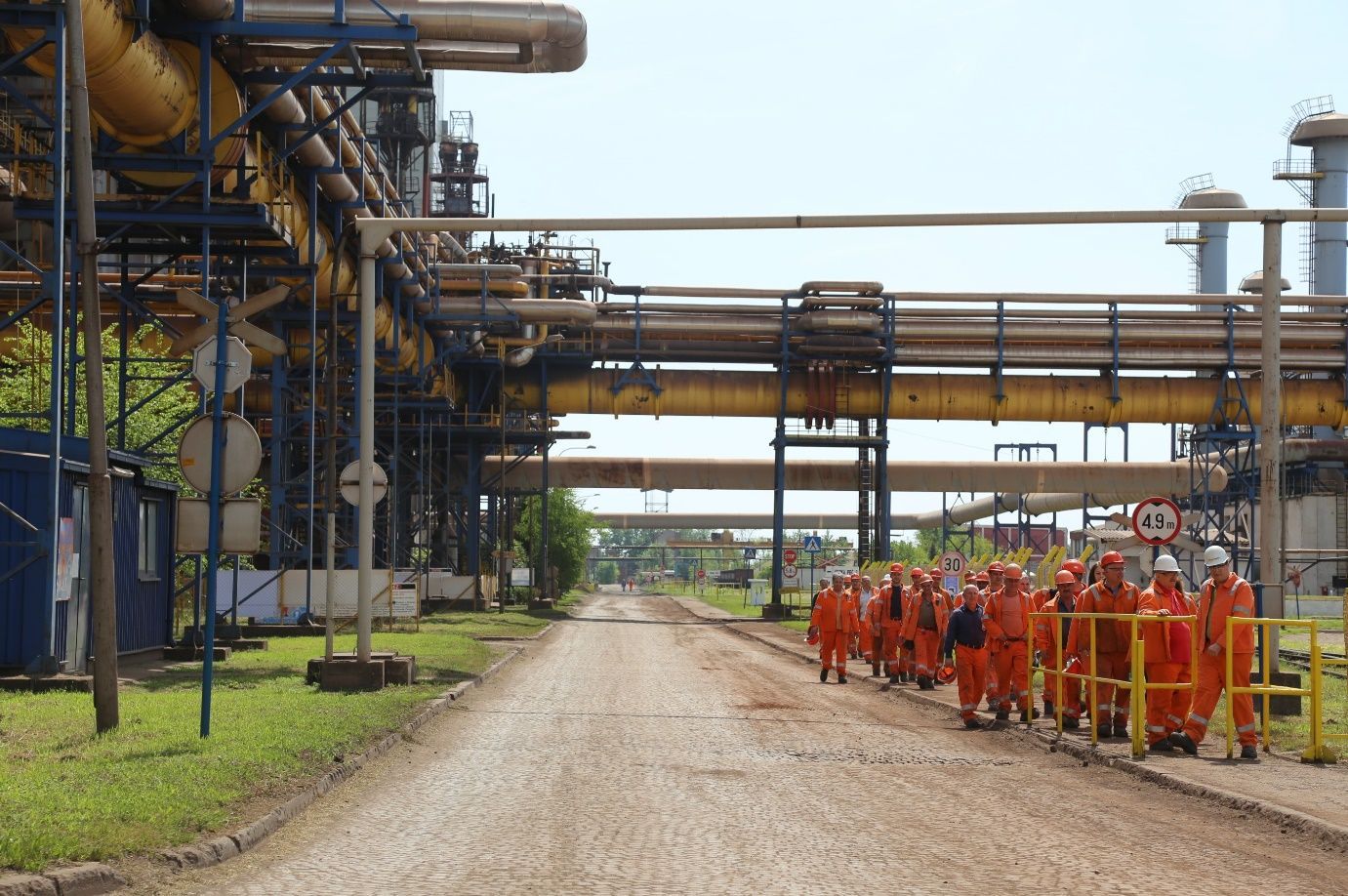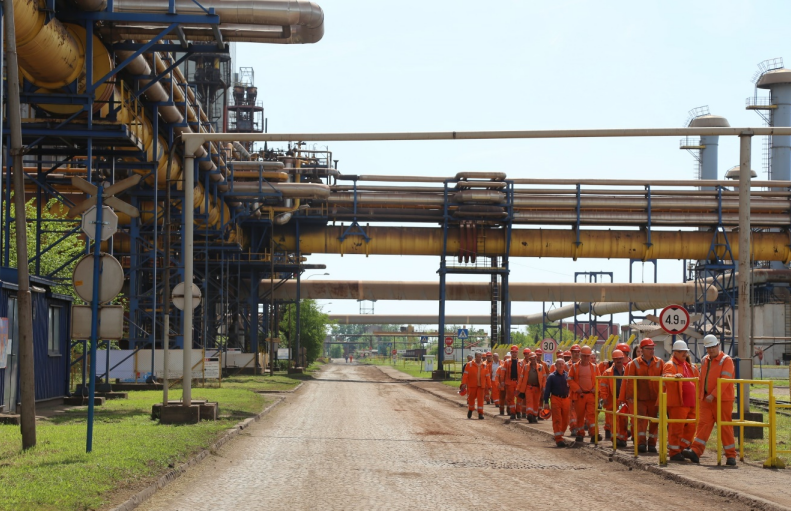
Workers in the plant of HBIS Group Serbia Iron & Steel d.o.o., April 18, 2016. (Xinhua)
BEIJING, April 26 (Xinhua) -- Along the quiet, blue Danube River stands Smederevo Fortress, a medieval castle and the largest ancient castle on the European plain. Since the 15th century, Smederevo had been witnessing ups and downs. In modern times, the city revived due to steel industry. Founded in 1913, the only state-owned steel plant was a witness to the pride and ambition of the past Serbia. Yet, the plant gradually declined and the once ambitious city lost its glamour.
Looking into the cityscape of Smederevo, you can catch sight of the high-rise boilers and cooling towers of the steel plant. Many years ago, each morning people in Smederevo used to bending over windows and overlooking the chimneys of the blast furnaces not far away. A smoking chimney meant that the plant was in operation, and people can start a new day with ease. Yet not everything goes just as one wishes, the furnaces had not burnt for long, and the cooling towers were colder.
"In the worst cases, we did not even know whether we will lose our jobs the next day. When everyone was at loss, a Chinese enterprise came," recalled Vladimir Ilitch, who majored in economics in college and now takes charge of safety and fireworks of the plant.
It was full of uncertainties then. In 2003, Smederevo Steel Plant was acquired by United States Steel Corporation. During the following 10 years, the plant suffered sustained losses of 400 million U.S. dollars. In 2012, Serbian government bought the plant back with symbolic one U.S. dollar. Since then, the authorities had been trying to get it privatized with external capital, yet no substantial progress has been made.
In the first half of 2016, HBIS Group purchased the plant with 52 million U.S. dollars and founded HBIS Group Serbia Iron & Steel, which kept the 5,000-plus workers.
"My grandfather, parents, brothers and I have all worked in the plant. I feel happy and content with my present job, which gives me a sense of security and belonging. I would like to dedicate myself to my work," said 54-year-old Snezhana Devecerski from the company's purchasing department.
After the acquisition, HBIS Group Serbia Iron & Steel started to introduce advanced international operation experience of HBIS Group. Chinese technical experts were selected and sent to Smederevo, to offer equipment maintenance service for the plant. While ensuring production, the plant has followed a concept of "harmony and co-existence among human, steel, and environment". Facilities have been upgraded and transformed to save energy and cut emission. "Green-led" strategies were applied to protect the environment and ecology of Smederevo. Meanwhile, HBIS Group has also launched project cooperation with Primetals Technologies, US Harsco Corporation, Veolia Environnement S.A. of France, and other companies in the fields including energy utilization, slag utilization, coal-gas conversion, and sewage treatment.
The Serbian management team and production and technical personnel were also invited to HBIS Group for exchanges and training. By the end of 2016, just six months after the takeover by the Chinese enterprise, the plant turned a profit and reversed the trend of seven consecutive years of losses. In 2018, the company realized an annual output of 1.77 million tons, and registered sales of 1.05 billion U.S. dollars and profits of some 29.8 million U.S. dollars, the best performance in its history.
According to data from Serbian customs, the company exported goods of 847 million U.S. dollars in 2018, up 39.6 percent. For the first time, it became the largest exporter in Serbia, 39.57 million U.S. dollars more than the second performer, the Italian F.I.A.T.
"For many years, what I saw in Smederevo Steel Plant was only the chimney of a blast furnace, exhausting some smoke. And my business was also poor back then." Misic, who operates a restaurant in Smederevo, said, "Since the arrival of the Chinese company, another long-closed blast furnace chimney of the plant started to send out smoke again."
"We are quite satisfied with our present cooperation and the achievements the plant has made," said Shasha Clark, head of ACHC, the second labor union, of HBIS Group Serbia Iron & Steel.
As the production and efficiency of the plant improve quickly, people's purchasing power has also been enhanced, which has boosted local business. Banks now are also more ready to offer quality services for enterprises and individuals. The whole Smederevo has been brought back to life.
Currently, one out of five people in Smederevo is working for the plant in one way or another. Jasna Avramovic, mayor of the city, said, "Smederevo Steel Plant is the economic and industrial foundation of the city, and also represents a success story of acquisition in Europe." She said that the Chinese enterprise enjoys advanced technologies and abundant capital, while Serbia has prime location, rich production and competent workers. That is why the two partners can complement their advantages.
Thanks to the rebirth of the plant, Smederevo has seen a more than doubled fiscal revenue each year. As a result, local education, medical care, transport and other living conditions have been greatly improved. The 60-year-old mayor said with pride, "Now Smederevo ranks top in Serbia in terms of birth rate."
"Before the acquisition, each month Serbian Government has to allocate 10 million U.S. dollars from tax revenue to subsidize the plant. The plant turned a profit at the end of that year," said Dragan Stevanović, State Secretary of Serbia's Ministry of Economy. The plant has contributed 1.8 percent of Serbia's total GDP, so its operation has a direct bearing on the economic development and social stability of Smederevo, and the national economy and the people's livelihood of the whole Serbia.
Serbian writer Milorad Pavic once wrote: "Time that has elapsed in one town is just beginning in another, and one can travel between these two towns forward and backward through time."
Today, time had vanished but also returned to the same factory. Here you can walk into the future, a future featuring friendly cooperation between China and Serbia along the Belt and Road. (Contributed by Wang Huijuan, edited by Li Haoran, Hu Pingchao)




 A single purchase
A single purchase









